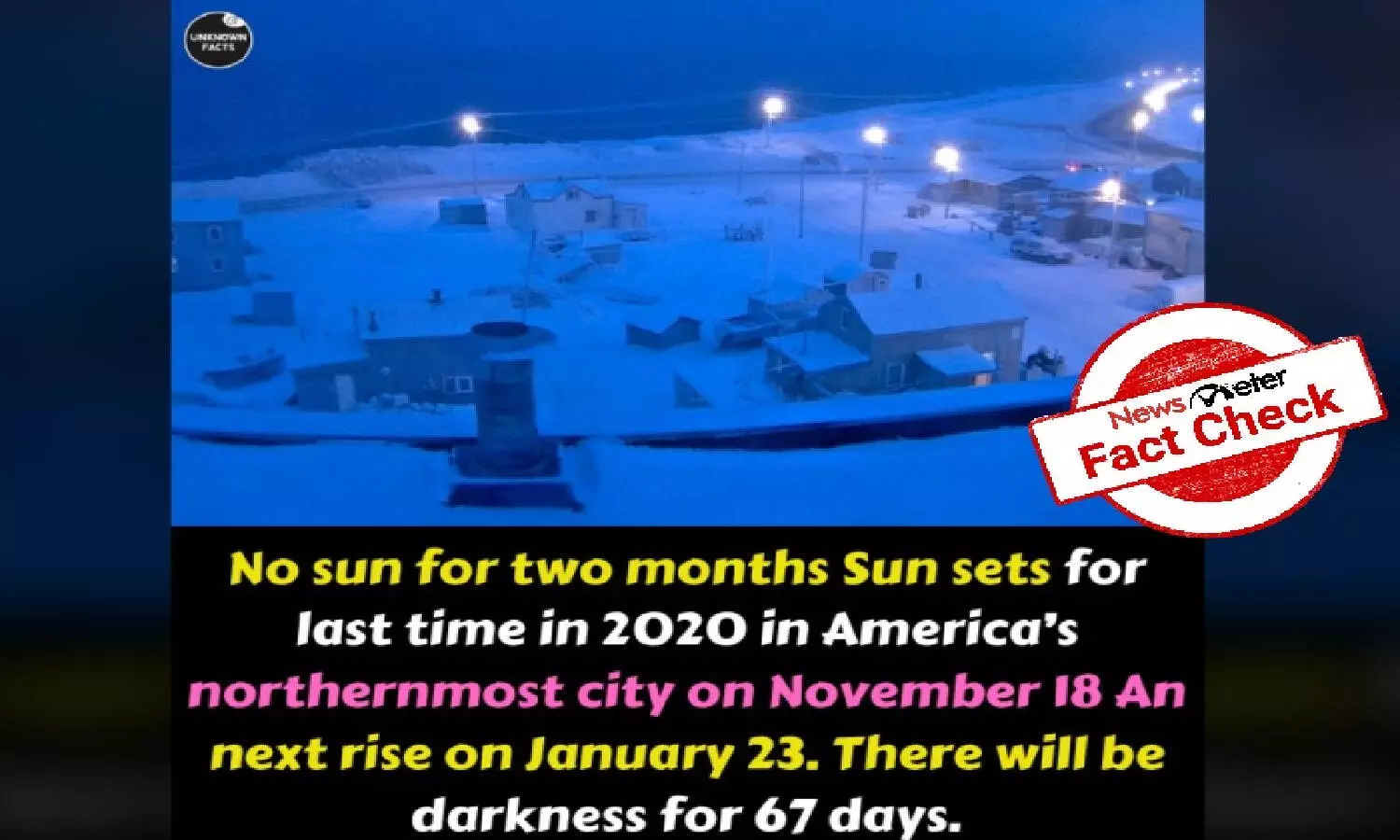Fact Check: It is true that the northernmost city in America will see darkness for 67 days
America's northernmost city on 18 November and the next sunrise will be on 23 January. There will be darkness for 67 days
By Satya Priya BN
Hyderabad: A photograph of a place covered in snow and illuminated with lights is being shared on Facebook with a caption that said, "No sun for two months. Sun sets for the last time in 2020 in America's northernmost city on 18 November and the next sunrise will be on 23 January. There will be darkness for 67 days."
This claim has also been tweeted with the caption, "In the town of #Barrow in #Alaska, the Sunsets on November 18th, 2019 and rises on January 23rd, 2020. During this period there is total darkness for 67 days. Also Barrow has 87 days of uninterrupted sunshine in the summer. #CdnWx #ArcticLife (sic)."
In the town of #Barrow in #Alaska, the Sun sets on November 18th, 2019 and rises on January 23rd, 2020.
— MacJordan 🇨🇦🇬🇭 (@MacJordaN) December 15, 2019
Between this period there is total darkness for 67 days. 🌚 🌚
Also Barrow have 87 days of uninterrupted sunshine in the summer. ☀️ ☀️ #CdnWx #ArcticLife pic.twitter.com/9FWmYb4DFP
DID YOU KNOW ? 😱
— KUNLE O N T A R I O 🇨🇦 (@kunle_pata) June 2, 2020
In the Town "Barrow" located in Alaska, the sun sets on November 18 and rises January 23.
Between this period, there is a total darkness for 67 days. pic.twitter.com/50rko2nFzC
Archive links:
https://web.archive.org/save/
https://web.archive.org/save/
Fact Check:
The claim that the city of Utqiagvik/Barrow will stay in darkness for 67 days till 23 January 2021, is TRUE.
This city Utqiagvik, formerly known as Barrow, is in the state of Alaska, USA. It has seen its last sunlight of 2020 on 18 November.
According to an article in the Washington Post, the extended darkness is courtesy of 'polar night', a phenomenon that occurs at high latitudes in the Arctic and Antarctic circles each winter. Because of Earth's tilt, regions in the Arctic circle can remain facing away from the sun for days, weeks, or even months at a time between the fall and spring equinoxes.
The opposite is true in the summertime when brightness reigns 24 hours a day in the "land of the midnight sun."
As the earth rotates around the sun, it does so at a 23.5° angle. As we get closer to the first day of winter, the sun's direct rays inch closer to the Tropic of Capricorn (in the southern hemisphere). This means that the Arctic circle is tilted away from the sun over the next two months. On the contrary, when the sun's direct rays are closer to the Tropic of Cancer (in the northern hemisphere), areas in the Arctic Circle won't see sunset from mid-May to early August, reported WSLS news.
Another report stated that, even though there won't be an official sunrise for more than two months, that doesn't necessarily mean complete darkness all the time. At its brightest, however, it will look like twilight as the sun gets close to the circle but never rises above the horizon, similar to how we see light even after the sun has set. This phenomenon occurs every year.
In the warm season, the opposite is true. The northern hemisphere is tilted towards the sun and therefore the sun won't set for a couple of months. This is also known as a polar day or the midnight sun.
According to a report published by the CBS news in 2016, Barrow, which is located on the Chukchi Sea coast at the northern tip of Alaska, is home to slightly more than 4,400 residents, many of whom still hunt and fish for food. It's a city where the sale of alcohol is banned, and one bank serves the entire community.
Hence, the claim shared on social media that the northernmost city in America will not see sunrise until 23 January 2021, is TRUE. The last sunset was on 18 November 2020, and the next sunrise will take place after 67 days of darkness.